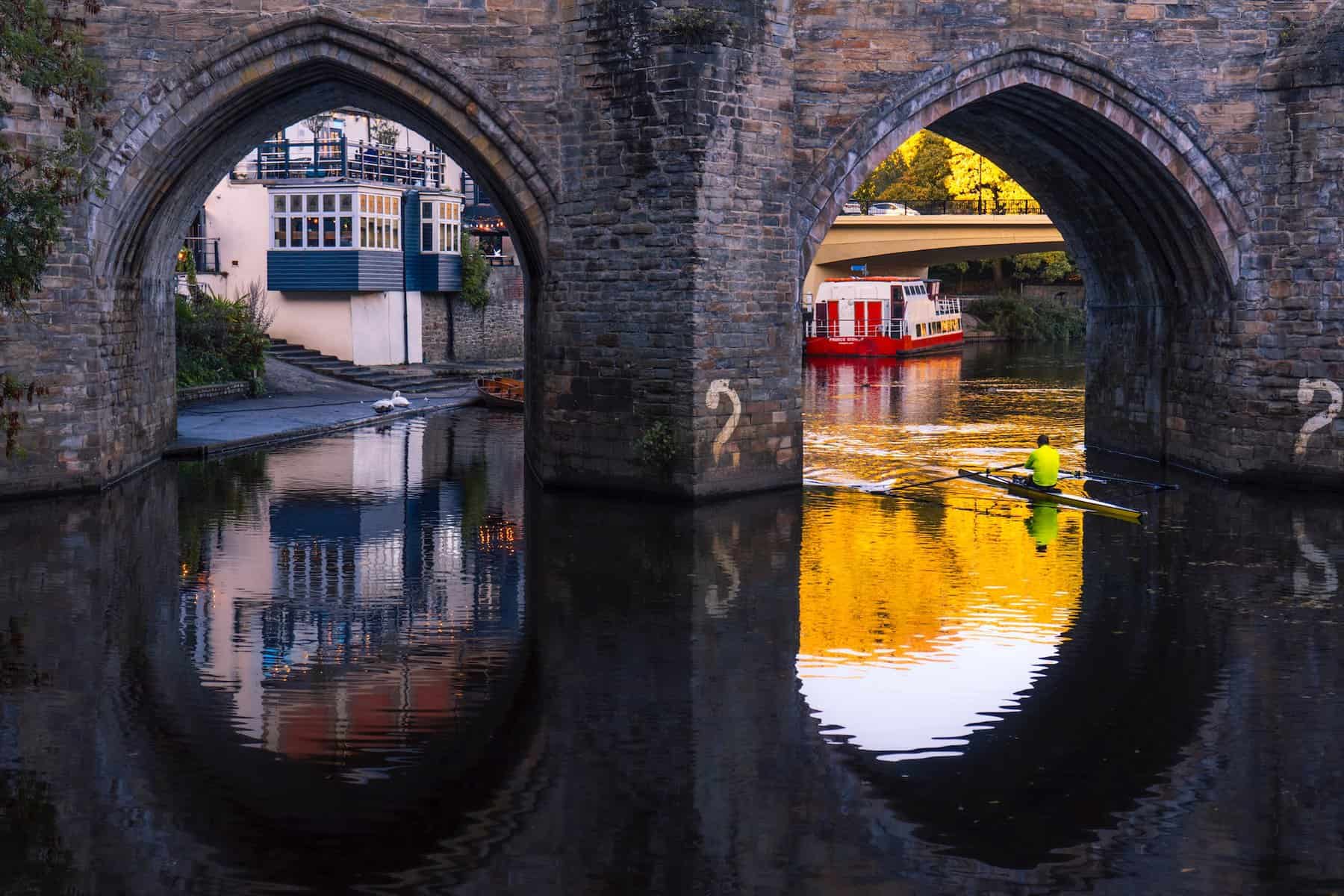The UK’s Prettiest University Town: What is Durham University Like?

- Originally published
- Last updated on February 17th, 2024 at 08:41 pm
Table of Contents
Durham University seems a lot like the historic “ancient” universities of the UK: for one, you can live in a castle, that dates back to some of the first Norman architecture in England. For another, the university utilizes a very Oxford-like “collegiate system” in which students are assigned to small social enclaves within the greater university system.
Yet Durham University only dates from the 19th century, when it got its royal charter as a university and began the earnest journey to educating England’s finest.
Today, it has a reputation for being a wealthy enclave in a working-class region of England, a place where locals don’t dare tread, but instead, “rejects” from Oxford and Cambridge spend three happy, cloistered years as clueless to the real world as the monks that came before them.
Is there any truth to that?
We wanted to find out: What is Durham University like? For real?
Durham University by the Numbers
Degrees: BA, MEng, LLB, BSc, MSci, MChem, MBiol, MPhys, MMath, BEng,
Majors: Over 100 undergraduate degrees, many with a 4th-year master’s qualification (or placement year, or study abroad year) built-in. There are 79 traditional 3-year degrees. Geosciences and Space Science rank in the global top 100 by US News, while QS also rates ancient history, archaeology, geography, anthropology, theology, philosophy, history, English literature, geology, earth sciences, law, and geophysics, in the top 50.
Location: Durham, Durham county, UK (about 15 minutes south of Newcastle upon Tyne by train)
Cost for international students: £25,550 for philosophy, £25,750 for law, £27,600 for business, economics, £31,250 for geoscience, biological sciences, engineering, and similar lab fields.
On-campus housing cost: £6,806 for single rooms with a shared bathroom for the 39-week term, or £9,745 including meals/board. Room rates alone rise to £10,199 for studio apartments. An en suite room plus catering costs £10,370.
FAFSA Funds: Yes
Abroad from abroad: Yes, but you may incur a year of added study and expense. Summer and winter programs are also available, but those partnerships are only published for logged-in students. Academic year placements come from partner universities and are limited by your program of study: for instance, history students wanting to study in Europe have options in France and Germany — and they’ll have just one single option in Paris if they’d like to study in English.
Student body: 22,130 students, with 4,500 international students from 156 total countries.
Five adjectives: Historic, collegiate, homogenous, picturesque, ambitious
The Making of Durham

With 94,000 locals and 22,000 students, the charming town of Durham suffers from an identity crisis: is it locals or students who rule the roost? In classic “town vs. gown” fashion, locals and students in Durham often live in totally different worlds, and this divide is exacerbated by the fact that Durham admits under 10% of students from its own region of England, fewer than any other British university.
This Cathedral city has always had a scholastic bent. Founded by Benedictine monks hoping to hide the relics of St. Cuthbert from marauding Vikings, academic endeavors of the original priory were extensive. Monks copied religious texts, amassed libraries, and helped preserve knowledge at a time when books were expensive.
Durham expanded from the church, to a new Cathedral, and eventually a Norman castle, which has been occupied by the university since the mid-19th century. Long a growing northern merchant town built on scholasticism, ideas for a university were floated by Henry VIII in the 16th century. Sadly, these plans were abandoned, resurrected, and shelved again before the university was finally graced with its royal charter. In spite of the multi-century delays, Durham still claims it’s England’s third oldest university, though other UK universities lay claim to this title, too.
Perhaps, if history stopped there, Durham would be a largely academic town in which largely academic inhabitants did largely academic things. But as a religious center, it attracted merchants, laborers, and artisans. Stonemasons built its cathedral, and weavers clothed the masons. Farmers fed the workers, pub owners housed those on pilgrimages, and ultimately, a bustling economy emerged on the site of this hillside fort.
In the 19th century, nearby coal fields fueled industrial growth across England but put a dent in relations between locals and students. Even today, the Coal Miner Gala (a parade and festival) commemorates the role of blue-collar labor around these parts, and “pit villages” radiate from the city center, some with a more “locals only” vibe than others.
Today’s Student Experience in Durham: What is Durham University Like?
To get a feel for today’s Durham, buy a ticket and climb to the top of the Cathedral for unparalleled views over the town. You’ll be able to see all the way to Newcastle, your best bet for shopping and big-city nightlife for your next three years. But you’ll also soak up plenty of Durham’s own quaintness.
Check out “Cardiac Hill,” where you’ll huff and puff on your way to class, and “Arse Hill,” where you’ll develop great glutes on your way back home to your college. You may hear that getting around Durham can be “uphill both ways,” and understand why that’s the truth.
There are cobblestone streets leading in every direction, and a compact central city with tiny medieval alleyways making the city feel cozy. Look east out to Gilesgate, down a walk that thankfully doesn’t involve climbing another hill. That’s where you can see a show at the Old Cinema Laundrette and find tons of charity shops and cheap eats.
“Durham is perfect for students. It’s small and homey but there are also galleries, museums, and theater you don’t normally get in a town this size.
Durham is naturally hemmed in by a bend in the River Wear that creates a peninsula where Durham’s main attractions, and many of its core university resources, are found. Food, groceries, pubs, and theaters are clustered at the top of the peninsula, and you can also find an indoor Market Hall where you can pretend you’re a medieval trader, or just stock up on fresh fruits and succulents for your dorm room. The Boat House is an institution where you may attend fresher’s week (orientation) events. Bobbing nearby is the Prince Bishop, where you might find yourself at a boat party.
It’s just a few steps over the bridge to find Durham’s malls, cineplex, and train station, along with the lion’s share of student housing. A walk on the towpath along the river will remind you why you chose Durham in the first place: crunch through fall leaves, watch rowers pulling their sculls out of the icy water, sit in a stone throne and survey your domain, and discover mills and follies that scream “Austen novel.”
That said, Durham students aren’t trapped in their own little river bend, called the “Bailey,” where the older colleges are clustered.
Many of Durham’s colleges are scattered throughout this compact town, which boasts a town and student population comparable to Boulder, Colorado, or College Station, Texas. Aside from the Bailey colleges, you’ll find the “Hill” colleges on the south side of the river down Elvet Hill Road. Bonus: the south side of town is also home to the Botanical Gardens, which are free for students and can help warm-climate Americans soak up some winter sunlight in the cacti greenhouse.
“You can walk around this city in 15 minutes. But that’s part of what makes it charming. Getting to know so many people is what made my college experience special. There’s this very quick process for bringing freshers into the fold at Durham and then, once you’re in, you have your group and you become very familiar with what seems like everyone in the city.
Costs, Safety, and Nightlife in Durham
Students appreciate that Durham has one of the cheapest costs of living in the country, and ascetics like Durham’s monks have saved cash here for centuries. Prices can be less forgiving in some of the most charming historical pubs (and with the current housing crisis). Yet there’s affordable public transportation and affordable groceries (albeit at one small grocery store).
Check out local institutions like the Vennels Café, where mustard was invented, or Whitechurch, with its spectacular burgers with multigrain buns, or even Bohemia for an upscale collegiate club experience (oddly combining a ball pit and a dress code). Babylon is Durham’s staple club, a cavernous space with multiple screens. While students complain about the prices, these places undercut their London counterparts and cater to a collegiate crowd used to pinching pennies.
Durham has awesome nightlife with the best themed club nights, the favourites being Taylor Swift themed nights, fractal- dnb, and tekkno themed nights.
Durham’s affordability doesn’t equate with danger in the center of the city. In fact, Durham is overwhelmingly safe, especially compared to larger cities. Nevertheless, the Student Union runs a night-cab service for £3 to get students between colleges, home, or to the train station until 2:00 am most nights.
Students don’t need to go to Newcastle for nightlife, but they can. Some people might go every couple of weeks. And having that outlet can help when you’re feeling like, ‘Oh, it’s just Southerners here [in Durham],’ or ‘Oh, it’s just students here.’
The night-cab is particularly useful in the winter term when Durham sees more snow and ice than England’s southern universities. Drifts pile up against stone shops, making university buildings all the more picturesque, but making Durham’s “uphill both ways” landscape particularly treacherous.
Remember, Durham’s hills make the town prettier than Oxford or Cambridge. However, it also makes it far less bikeable. In fact, biking in town is so foreign a concept that the five bike lockers at the city’s bus station sat empty for five years because no one knew how they worked. Main thoroughfares with “cyclists dismount” signs here mingle with empty bike racks.
Nevertheless, adventurers will find Durham a great base camp. There’s nearby Hamsterley Forest for hardcore single track lovers, and easy access to touring routes like a coastal that can take you through neon yellow rapeseed fields, past ruined towers to windswept Seaham Beach.
Uni Buildings and Facilities: Sports
You’ll see familiar faces all around Durham, which students describe as “cozy,” but also “insular.” The town seems to lend itself to the feeling that all of campus is Durham city, and all of Durham city is a campus, a special, historical place for students. That dynamic means that there are informal support structures for students and a sense of community that universities in London just can’t match.
It’s a community feel. I wasn’t prepared for just how small Durham feels compared to London. It’s quite a good change. And the collegiate system adds to that because it makes it inevitable you’ll make friends and know people right from the start.
For sporty types, there’s an American football team at Durham, so suit up and live out your college ball dreams. Durham has been named the “sports uni” of 2023, and has been in the top 3 since 2016, so there are plenty of opportunities to get involved and get a good workout here, even if football isn’t your thing.
In fact, Durham has produced more pro players than any other UK university, but keep this distinction in perspective: Durham is notable for its “high” number of 12 sport scholarships awarded to students each year (the UK has a very different cultural take on college sports to the US). The recreational approach to sports in the UK means that many teams welcome newcomers to try their luck at a new sport, giving more students the chance to participate and enjoy the 700 different sports teams (or with even less performance pressure, the 380 intramural teams).
And you can practice your new sport of choice (polo, anyone?) in a multimillion-dollar sports facility, Durham’s Maiden Castle Sports Complex. While some facilities are renowned and reserved for team members, students looking for basic fitness machines and classes find extensive fitness rooms and classes ranging from flexibility to circuit training. You’ll find an indoor rowing tank, fencing piste, and outdoor classes in the springtime. It’s the best gym in town, but it’s also one of the best university fitness centers in any UK university.
The classes and facilities are so good mentally. It can be too dark to go running along the river most of the year and the fitness center is amazing and keeps you moving when you’d rather not be outside. It’s almost better to be at the fitness center, with picturesque views of the castle you just can’t get in any other uni.
Cool and Wacky Finds On and Off the Peninsula
University buildings are scattered throughout the rest of town, with the oldest, most jaw-dropping spots on the Durham peninsula. Don’t miss the Cosin’s Library on Palace Green. It holds the rare books that will remind you of Durham’s long scholastic history. It’ll also inspire you to write your masterpiece just so it can be housed in this wood-paneled edifice, complete with a fireplace and spiral staircase. The Palace Green area is everything you hoped historical Durham would be, but the majority of lectures take place in more utilitarian buildings.
The college’s main library is just over the river from the south end of the peninsula at the Science Site, so it’s roughly equidistant for students on both sides of the river. With its glass wall, it’s a modern, light-filled space that can be busier than the pub at 11:00 p.m. on a Friday night. Stake out your seat, come prepared with a brown bag lunch so you won’t ever have to give it up, and you’ll be living like a true Durham student.
Overall, Durham has a town vibe. It’s not a campus university, though many of the campus buildings on the south side of the river are clustered together along a thoroughfare with plenty of greenery. Yet there’s a mix of modern, best-of-class facilities nestled in the cobblestone streets and flowered walkways.
The student union building, which could exude riverside charm, is instead a “concrete carbuncle” that’s gained historical protections in the UK, and can’t be demolished. A business school remodel is in the works. And the 6-year-old Mathematical Sciences and Computer Science building gives students places to study, congregate, and gaze out to the thoughtfully landscaped courtyard while talking tech.
Life in Durham: College and Independent Student Housing
Because of the college system, you’ll find diverse housing at Durham. There are self-catered colleges, in which new students share a kitchen, some with en suite bathrooms and others with shared baths. Each college also comes with its own image, from Collingwood, the “sporty college” to Hatfield, “the posh one.” It’s sort of like the Spice Girls.
Typically, all colleges have common rooms, libraries, small gyms, and bars, though some share a gym between colleges (Josephine Butler and Stephenson, for example). They also come with their own clubs and societies, so be sure to check out opportunities for theatrics or music while making your decision.
Hill colleges can be far afield from Durham town. At the far end, you’ll be hiking about half an hour to the oldest part of campus. And when you walk down the hill, you’ll have to hike back up. That’s great for students who frequent the science buildings in this part of town and those that value more green space, and for those with the willpower to fight the “food delivery” urge.
Certainly, the distance to easy amenities can mean that residents of the Hill colleges can fall prey to inertia.
“If you’re self-catered, make sure you hang out in the kitchen. You’ll meet everyone in your townhouse, and that’s an easy way to get to know people.
Choosing between Colleges and Accommodation
In general, Hill colleges are newer and cheaper, with bigger rooms and en suite options. They’re also less charming and farther from (humanities) college classrooms and downtown amenities.
Because Bailey colleges are catered, they’re generally pricier and because they’re historic, they have a reputation for accommodating more students from wealthy backgrounds. A typical room arrangement is called a “townhouse.” For those looking to save cash, self-catering colleges are in high demand (and rare).Townhomes are a lot like giant homes: you’ll find multiple stories, with many bedrooms on each level, a common lounge, a kitchen, and multiple bathrooms, some of them private en suites attached to a bedroom. The system allows students a mini-home within their college and 20 or so housemates.
Durham applicants find college allocation a lot riskier than Oxbridge students, who overwhelmingly say they come to recognize “their” college as the best in the university, even if it wasn’t their first pick. At Durham, some folks strongly prefer Bailey or Hill colleges, and Castle is especially popular. Unlike Oxford and Cambridge, Durham students get a university acceptance before they apply to a particular college, so you won’t have to worry about picking a college that seems to offer an easier pathway to Durham itself. If your first-choice college has too many requests to accommodate everyone, students are allocated to another college.
Choosing a college based on your dream accommodation may only be an issue for first years, so keep your long game in mind when choosing a college. In subsequent years, as students move off-campus, they find themselves venturing far from the beloved Bailey anyway.
That will be more expensive than you’d think for this remote region of the country. Currently, student rentals in town often top £200 per week and ability to pay top dollar is no guarantee of housing. Neither is sleeping overnight on doorsteps of local realty companies. In October. For next year. Privately-owned student dorms to alleviate the housing crunch are in the works, but students worry that market solutions will continue to offer up little more than sky-high prices.
While the city’s accommodations have been a point of contention, students say it’s getting better:
The uni has made it easier for students to get college accommodation as a 2nd, 3rd or 4th year, They made sure that everyone was better prepared for finding housing this year through workshops. There is also a Durham Uni “find a housemate” Facebook group open to all university students, including postgraduates.
The bottom line? Don’t panic. Students tell us they have jumped the gun, scared they wouldn’t be able to find housing. They ended up hastily choosing a place to live or a group of roommates. Ultimately, we heard from students who said they wished they’d waited longer, not that they waited too long and were out in the cold.
Durham Student Life and Academics
Sometimes it’s a student. Sometimes it’s the leader addressing an entire auditorium at an orientation event that makes you squirm in your seat. But inevitably, someone will ask you if you were rejected from Oxford or Cambridge. It’s guaranteed.
While Durham University is ranked far behind #5 Oxford and #8 Cambridge, coming in at #277 globally by US News, it maintains its “heritage on a hill” caché, nonetheless.
Perhaps it’s because students at Durham apply because they’re seeking a “college” experience, with small academic communities clustered in a large university. It could also be because medieval buildings and an old-world vibe coupled with a quiet, academic town appeals to the same applicants. Whatever the reason, Durham University comes away with a stellar academic image despite significantly lower rankings than Oxbridge.
However, Durham University also ranks among the best of the best in some subjects: in the UK, they’re in the top 5 for theology and religious studies, history, classics and ancient history, English, economics, general engineering, physics, and biology. So it makes sense that among schools in England, students looking to stay local (and even just national), and live in a castle to boot, overwhelmingly choose Durham.
Friends at Durham
While there, they’ll find lots of ways to meet people. Aside from colleges, which can feel like their own social spheres and have their own sporting teams, clubs, and societies (and even theaters and jazz bands, in the case of Durham). There are also plenty of university-wide student societies.
Clubs cost about £5 to join, which offsets materials for craft nights, movie rentals, and snacks all year long. Societies help students quickly acclimate, find their people, and get settled in university life. From those celebrating Barbie to supporting students educated at public schools, along with fans of Chinese Tea Arts, cheese, Eurovision, potatoes, Disney, and crochet, Durham students find plenty of ways to meet new people.
There’s even an American society at Durham University, which can be difficult to find at UK universities, but a godsend for students who need a weekly check-in with compatriots. American societies typically offer events like World Series viewing, Thanksgiving meals, and the rare chance to say “cookie” without comment.
Durham academics come with an academic tutor (sometimes called a mentor) to see you through paper writing and general academic woes. There’s no tiny-group workshopping, à la Oxford and Cambridge, but rather some scheduled check-ins. Tutors are a mash-up of an academic advisor and writing center coach, helping students stay on the right track. They can refer you to a senior tutor and even weigh in on career advice. You’ll meet with a tutor at Durham at least twice per term.
“College parents” and families, with everything from “siblings” to “uncles” in your college can also help smooth the transition to university. Your mileage may vary. Some newcomers have supportive mentors in these older college-mates, while some find they don’t follow through.
Burning the Midnight Oil: Studying at Durham
Academic life at Durham can look like many other universities in England: you’ll attend lectures with up to 250 other students, and attend break-out discussion sessions. Most of the classes in each major are required, with a handful of electives you’ll choose at the beginning of term. For example, if you’re taking a BA in Geography, you’ll take a handful of foundational classes in your first year, like “Introduction to Geographical Research,” “Physical Geography, and “Human Geography.”
At Durham, most modules are centered on attending talks, or lectures, and learning the canonical theory in your field. Lecturers are research-oriented, as might be expected in a Russell Group university where research prowess is weighed heavily in rankings and in the vetting of professors. It can be an advantage for students aiming for graduate school, too, who want to learn from the very people doing cutting-edge work in their fields. Theory-heads are happiest at Durham, but practically-minded students find they can squeeze more value out of their degrees by experiencing a work placement or a year abroad at a university with a more hands-on approach.
Every course is different, so in some ways, it’s simple to compare to other universities to see if Durham’s program interests you. However, the teaching and learning style is something to be aware of. Not everyone appreciates the lecture style. There is a lot of theory in many of Durham’s courses, and not a lot of engagement, especially compared to American universities. In some ways, that’s very British in general, but Durham is at the far end of the spectrum.
You can opt for a third-year placement or study abroad (both of which will earn you a 4th year of study back in Durham to complete the BA). Both options are popular. In some fields, the university is instrumental in placing students in work placements. That gives students some peace of mind – their education isn’t reliant on them finding a placement for themselves and hoping it affords them the skills they’re seeking. Bonus: placement year internships are paid, so students can pocket around £20,000 as well as a line on their resumés.
In students’ final year, they’ll take on an undergraduate capstone paper (called a dissertation here, but don’t get it confused with the book-length manuscript a Ph.D. student in the US completes). Structured like a master’s thesis, it’s a 40-ish page paper on a topic students want to dig into.
Durham’s strategic plan calls for a growing student body, which stands to increase tension in overfull classrooms, and students say their time with professors is less than they’d like it to be. They say that some lectures have gone remote due to overcrowding, and that there’s barely any room available in the library or the Teaching and Learning Center, where students go to find quiet study space to work on their assignments.
In spite of Durham’s growing pains, over 80% of students come away from Durham saying that they’re overall satisfied with the education they received. Durham ranks in the top 20 for student satisfaction in the UK (of the National Student Survey’s 500 eligible institutions).
Applying to Durham University
Individual colleges have merit and need-based scholarships available to students, so look into specific college funding options that may apply to you. For example, St. Chad’s offers choral and organ scholarships annually! Colleges manage their own finances, and some may offer more support than others.
That’s a task for once you’ve already been admitted. To apply to become a new “fresher” in some of Durham’s most elite programs, you’ll need three AP exam scores of 5, or 2 AP exam 5’s and an honor’s class with an A+ grade, an SAT of 1390 or higher, or an ACT score of 30 or above. You can also apply with a college-level course with a grade of “A.”
Durham courses with lower requirements may only require 1 AP test with a score of 5 and 2 AP tests with scores of 4.
Durham includes criteria for students applying from schools with no AP curriculum. They’d like to see you graduate with a 3.7, having taken 3 honors classes in grades 11 and 12. Take note: acceptances will be conditional on you achieving the required grades and coursework by graduation.
Course-specific AP requirements may apply. Students eyeing programs that require British students to complete secondary school work in English will have to take AP English Literature and Composition, for example. Durham doesn’t take direct applications for undergraduate study (though you can apply directly as a postgraduate). You can apply directly to the International Study Centre (if you don’t currently meet the admissions requirements and need a year to get college-ready at Durham).
Apply through the UK’s UCAS portal, including a report of your high school transcripts, a personal statement, a letter of recommendation, and required test scores. UCAS charges £27.50 to apply for up to 5 total programs (at up to 5 schools) for 2024.
Not Sold on Durham? Check out the Competition
Oodles of students will tell you to look at Oxford and Cambridge. But there’s a whole world of other universities in England, so don’t be shy. Grab a map of England’s universities, then filter by Russell Group (research-focused) universities, or red brick charmers, and discover your perfect city.
Don’t forget to get acquainted with the basics of college life in England while you’re at it, for information about how to work, study, and get a visa in the land of Churchill.
Related Posts

Jessica Share
Jessica is the writer, Ph.D., and mom-of-an-abroad-student-in-the-UK at the helm of College Abroad Guides. When she's not asking college students where the coolest place to hang out in their city is, she's figuring out how she can make $60 imported Greek oregano potato chips and £50 British bacon potato chips appear on her doorstep for the cost of a local bag of Lay's.





